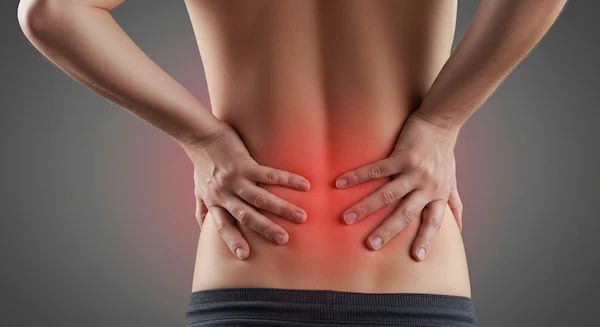Guide to Habits Get Rid Frequent Back Pain
Discover effective habits and lifestyle changes to reduce and prevent frequent back pain. Improve posture, strengthen muscles, and live pain-free.

Written by Dr. Dhankecha Mayank Dineshbhai
Reviewed by Dr. D Bhanu Prakash MBBS, AFIH, Advanced certificate in critical care medicine, Fellowship in critical care medicine
Last updated on 13th Oct, 2025

Introduction
If you're reading this, you're likely all too familiar with that nagging, stiff, or sometimes sharp sensation in your back. You're not alone. Back pain is one of the most common reasons people miss work and seek medical care. But what if the key to getting rid of this frequent back pain wasn't a magic pill or a single adjustment, but a series of small, consistent changes to your daily life? This guide moves beyond temporary fixes to address the core habits that contribute to spinal health. We'll explore how your posture, movement patterns, sleep, and even stress levels play a direct role in either causing or alleviating discomfort. By understanding the "why" behind the pain, you can empower yourself with practical strategies to rid your life of this burden and build a stronger, more resilient back. This article will walk you through seven transformative habits, supported by science and practical advice, to help you achieve lasting relief.
Habit 1: Master Your Posture – Beyond "Sitting Up Straight"
Poor posture is a primary culprit behind chronic back pain. It places uneven stress on your spine, leading to strained muscles, compressed discs, and inflammation. Mastering posture isn't about being rigidly upright; it's about alignment and movement.
The Sitting Epidemic: Why Your Chair is Your Enemy
The modern sedentary lifestyle is a major challenge. When you sit for prolonged periods, pressure on your lumbar discs increases significantly compared to standing or lying down. This can lead to disc degeneration and muscle imbalances—your hip flexors shorten, and your glute muscles "switch off," forcing your lower back muscles to overcompensate. The goal isn't to never sit but to sit smarter.
Your Daily Posture Checklist: From Desk to Dinner Table
Desk Setup: Ensure your feet are flat on the floor, knees at a 90-degree angle. Your screen should be at eye level to prevent neck strain. Use a chair with good lumbar support or a small pillow behind your lower back.
The 30-Minute Rule: Set a timer to stand up, walk around, and stretch for one or two minutes every half hour. This simple habit for back pain relief changes everything.
Standing & Walking: When standing, distribute your weight evenly on both feet. Avoid locking your knees. While walking, keep your head up and shoulders relaxed, not hunched forward.
Habit 2: Strengthen Your Core – It's Not Just About Abs
Many people think a strong core means having a six-pack. However, the most important muscles for back support are the deep core stabilizers, like the transverse abdominis, which acts like a natural corset around your spine.
The "Corset" Muscle: Your Body's Natural Back Brace
A weak core forces the smaller, more fragile muscles in your back to do all the work, leading to fatigue and strain. Strengthening your deep core provides stability, much like a strong foundation supports a house. This is crucial for preventing injuries during everyday movements like bending or lifting.
Simple Core-Strengthening Exercises You Can Do at Home
You don't need a gym. Focus on stability exercises:
Bridges: Lie on your back with knees bent. Lift your hips off the floor, squeezing your glutes. This engages the posterior chain.
Bird-Dog: On all fours, extend your right arm and left leg simultaneously, keeping your back flat. Hold, then switch sides. This improves coordination and stability.
Planks: Maintain a push-up position on your forearms, keeping your body in a straight line. This builds incredible endurance in your entire core.
Incorporating these exercises a few times a week can lead to significant improvement in lower back pain.
Habit 3: Optimize Your Sleep Sanctuary
You spend about a third of your life asleep, so your sleep position and setup are critical for spinal recovery.
The Best and Worst Sleeping Positions for Back Pain
Best: Side-Sleeping with a Pillow. Sleeping on your side with a pillow between your knees helps keep your hips, pelvis, and spine in neutral alignment. This is often recommended for pain relief.
Good: Back-Sleeping with a Pillow. Lying on your back with a pillow under your knees can help maintain the natural curve of your lower back and reduce pressure.
Worst: Stomach-Sleeping. This position twists the neck and flattens the spinal curve, putting stress on joints and muscles.
Choosing the Right Mattress and Pillow
A mattress that is too soft or too hard can exacerbate pain. A medium-firm mattress is generally best for most people with back pain. Your pillow should keep your head in line with your spine, whether you sleep on your back or side.
Consult an General Physician
Habit 4: Move Smart, Not Hard
How you move during daily activities is just as important as exercise.
The Perfect Lift: Protecting Your Spine During Daily Tasks
Never bend from your waist. When lifting anything—even a piece of paper—use the "hip hinge" technique: bend your knees, keep your back straight, and let your leg muscles do the work. Hold the object close to your body. This is a fundamental habit to prevent back injury.
Low-Impact Exercises That Soothe Your Back
When you have pain, high-impact activities can make it worse. Instead, opt for exercises that promote flexibility and circulation without jarring the spine. Walking is excellent. Swimming or water aerobics are fantastic because the water supports your body weight. Yoga and Pilates are also highly effective for improving flexibility and core strength, which are key to managing chronic back pain.
Habit 5: Manage Stress and Hydrate
The mind-body connection is powerful, especially when it comes to pain.
The Stress-Back Pain Connection You Can't Ignore
When you're stressed, your body goes into "fight or flight" mode, causing muscle tension—particularly in the neck, shoulders, and back. This chronic tension can lead to pain and stiffness. Practices like deep breathing, meditation, or even taking short walks can help break this cycle.
Hydration for Spinal Disc Health
Your spinal discs are mostly water. They act as shock absorbers between your vertebrae. When you're dehydrated, these discs can shrink and lose their cushioning ability, increasing the risk of issues like a herniated disc. Aim to drink water consistently throughout the day.
Habit 6: Ergonomic Your Environment
Look around your daily spaces—your office, your car, your kitchen. Make small adjustments to support your spine. An ergonomic office chair, a standing desk converter, or even adjusting your car seat to provide better lumbar support can make a world of difference in reducing daily strain.
Habit 7: Listen to Your Body's Warning Signs
Pain is a signal. Pushing through sharp or radiating pain can lead to serious injury. If an activity hurts, stop. Learn the difference between muscle soreness from a good workout and pain that indicates something is wrong. This habit of mindful movement is the ultimate form of self-care for your back.
When to Seek Professional Help?
While these habits are powerful for prevention and managing common aches, they are not a substitute for professional medical advice. If your back pain is severe, persists beyond two weeks, or is accompanied by symptoms like numbness, tingling, or weakness in your legs, it's crucial to consult a doctor. For convenient and expert consultation, you can talk to an orthopaedic specialist online with Apollo 24|7 to get a preliminary evaluation. They can help determine if you need further diagnostics, such as an X-ray or MRI, or recommend a course of physical therapy. Apollo 24|7 also offers convenient home collection for tests like vitamin D or HbA1c, which can sometimes be related to chronic pain issues.
Conclusion: Your Journey to a Pain-Free Back
Getting rid of frequent back pain is a journey of consistent, mindful choices. It's about building small, powerful habits into your daily routine that collectively create a strong foundation for spinal health. From mastering your posture and strengthening your core to optimizing your sleep and managing stress, each step you take brings you closer to a life with less pain and more freedom. Remember, progress is more important than perfection. Start with one or two habits from this guide, and gradually incorporate more. Your back is designed for a lifetime of movement—give it the care it deserves. If you ever feel unsure, remember that professional guidance from platforms like Apollo 24|7 is just a click away.
Consult an General Physician
Consult an General Physician

Dr. Dhanraj K
General Physician/ Internal Medicine Specialist
25 Years • MBBS, MD Internal Medicine - Osmania Medical College, Hyderabad
Hyderabad
Apollo Hospitals Jubilee Hills, Hyderabad
(400+ Patients)

Dr. Anand Ravi
General Physician
2 Years • MBBS
Bengaluru
PRESTIGE SHANTHINIKETAN - SOCIETY CLINIC, Bengaluru
Dr P Sai Avinash
General Physician/ Internal Medicine Specialist
5 Years • MBBS
Bengaluru
Apollo Medical Center, Marathahalli, Bengaluru

Dr Bhargav Vuppumalla
General Physician/ Internal Medicine Specialist
5 Years • MBBS MD GENERAL MEDICINE
Bengaluru
Apollo Medical Center, Marathahalli, Bengaluru

Dr Syed Mateen Pasha
General Physician
2 Years • MBBS
Bengaluru
PRESTIGE SHANTHINIKETAN - SOCIETY CLINIC, Bengaluru
More articles from Back Pain
Frequently Asked Questions
1. What is the fastest way to relieve lower back pain at home?
For acute pain, the R.I.C.E. method (Rest, Ice, Compression, Elevation) can help reduce initial inflammation. After 48 hours, gentle heat and light stretching, like knee-to-chest pulls, can promote healing. However, long-term relief comes from the strengthening and postural habits outlined above.
2. Can a bad mattress really cause chronic back pain?
Absolutely. A mattress that doesn't support your spine's natural curve can lead to misalignment and muscle strain all night long, resulting in morning stiffness and chronic pain. Investing in a quality, medium-firm mattress is often a worthwhile investment for back pain relief.
3. I have a desk job. What is the single best thing I can do for my back?
The most impactful change is to break up long periods of sitting. Use a timer to remind yourself to stand, walk, and stretch for 1-2 minutes every 30 minutes. This simple habit prevents muscle stiffness and disc pressure buildup.
4. Are there any specific foods that can help with back pain inflammation?
Yes, an anti-inflammatory diet can help. Focus on foods rich in Omega-3s (like salmon and walnuts), antioxidants (berries, leafy greens), and turmeric/ginger. Reducing processed foods, sugar, and trans fats can also lower overall inflammation in the body.
5. When is back pain a sign of something more serious?
Seek immediate medical attention if your back pain is accompanied by fever, unexplained weight loss, loss of bowel or bladder control, or severe, constant pain that doesn't change with position. These could be signs of a more serious underlying condition that requires prompt diagnosis.



